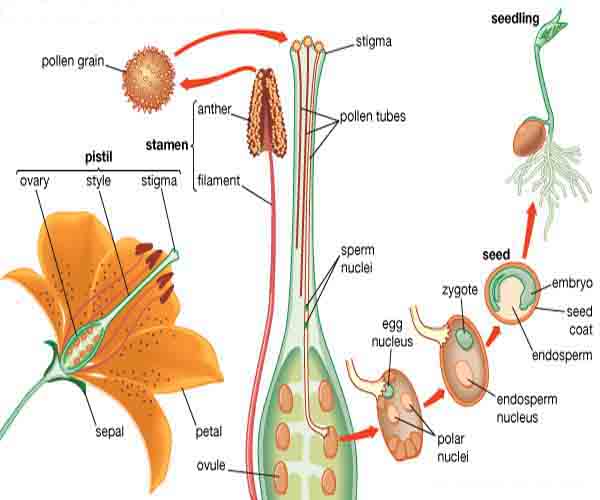Many of you will find this subject fascinating. There are many similarities between how humans develop and pro-create to how plants develop and reproduce. Just as adult humans don’t eat the same kind of foods or wear the same type of clothes when they were babies, plants don’t use the same nutrients throughout all their stages of growth or need the same amount of light.
All of us would laugh or thought it to be strange to see a thirty-year-old woman eating baby food. It would be a struggle for her to maintain her health and weight with just eating baby food. However, this is what some of you are doing to your plants and wondering why your veggies are sick looking. You need to know the growth stages of your plant to determine the nutrients they need to thrive.
First Stage – Seed Germination
The plant’s life cycle starts with germination of the seed. All you need is water, oxygen, and the right temperature for the seed to germinate. How about light? Well, most seeds are not affected by light or darkness, but some seeds will not germinate until they see sufficient light.
As the right temperature is reached, and water is provided, the seed will germinate. When a dry seed uptakes water, we call it imbibition. Imbibition means to drink; seeds imbibe water.
This process is so similar to a dry sponge exposed to water. As the sponge absorbs water, it grows in size. The color of the sponge becomes more vivant and becomes heavier. Seeds do the same.
Right temperature for germination
Most common annual vegetables have optimal germination temperatures between 75-89 F (24-32 C). Some species like radishes or spinach can germinate at significantly lower temperatures, as low as 40 F (4 C).
Swelling to grow
As the seed drinks water, it expands while enzymes and food supplies in the seed become hydrated. The seed is now activated and starts to go to work. The increased metabolic activity provides energy for the growth process. In addition, the water causes turgor pressure to increase in the cells.
Turgor pressure is the outward pressure that occurs in a plant cell when the seed’s cytoplasm and vacuoles fill up with water, and the cell membrane pushes against the cell walls. These guys swell up like water balloons in cells of the seed.
Time to make roots
Roots start to emerge from the seed. This activity is the first indication that the seed is viable and will grow. Eventually, the plant shoot, top of the plant, will sprout out and emerge from the seed.
Attached to the shoot are tiny leaves. Once these leaves begin to manufacture food, the plant will grow and enter the seedling stage.
Plant will now develop its first set of true leaves and roots.
The root growth that takes place at this time is crucial to how fast the plant will grow. Providing the ideal environment for the roots will ensure that your crop will have a chance to flourish.
What about the darkness?
If germination occurs in darkness, root growth slows after the shoot emerges and shoot elongation accelerates. This behavior occurs because the seed thinks it’s still covered with soil and needs to emerge from soil to see the light where it can obtain energy from the sunlight by photosynthesis. Once it is in the light, the plant undergoes dramatic changes like turning green and producing leaves. This transformation with the light is called photo-morphogenesis.
Second Stage – Vegetative and Growth
Now that the root system can support growth, the vegetative stage begins. Plant nutrient requirements call for a large amount of nitrogen for the production of chlorophyll. Growth during this stage is primarily dedicated to stem, branch, and leaf areas.
The most substantial growth over the life cycle of the plant occurs in the vegetative stage and will continue unless hindered by a change in environment or lack of water and nutrients.
Third Stage – Reproductive, Flowering and Fruit
The final stage of the plant growth is the reproductive stage. Since the objective is now to reproduce, the plant’s energies are directed to the production of flowers, fruits, and seeds.
Nitrogen is no longer the main nutrient the plant needs. We now need to boost up other nutrients like phosphorus and potassium (P-K). This is all due to a slowing down of plant growth.
Let it Bloom
This is when a change in nutrients are made, from vegetative formula to a flowering, or ‘bloom’ formula. This is why many aeroponics solution nutrients come as a two or three-part system.
In some plants, the reproductive stage is triggered by the change in the length of the daylight, this process is called photoperiodism. The length of the day is what governs plants grown outdoors to flower or produce fruit.
When growing indoors we must provide the right photoperiod for the crop to develop properly. Changing the length of artificial light can trick the plant to deliver flowers or fruits early. Commercial growers use this technique to provide flowers to markets out of season. As a reward, these growers demand a premium from vendors and customers alike.
Pollination – Spreading the love
Plants are pollinated by various means like wind, water or bees and other insects. Pollination occurs when the pollen from one plant is transferred to another plant. Reproduction in flowering plants begin with pollination, the transfer of pollen from one plant to the stigma of another flower or to the stigma of another flower of the same plant.

Pollination is required for the fertilization of the plant. Pollen contains the male gametes, or sperm, of the plant. The male gametes are transferred through this pollination process to the stigma of the plant. The stigma contains the female gamete (egg cell) where fertilization can occur with the male gamete.
When pollination occurs between plants of the same species it is called self-pollination. Pollination between plants of different species it is called cross-pollination.
Fertilization – This one is for you baby
Once the pollination is completed, a pollen tube grows into the ovary of the plant. The male gamete cells move along the pollen tube toward the ovary. Here the male gamete cell fertilizes the female gamete cell. This results in the development of a zygote. Zygotes develop into embryos and become the beginning basis of a new plant.
Now comes the seeds. A second male gamete cell fuses with polar cell bodies found in the center of the embryo sac, and produce the endosperm tissue material that provides food and energy for the development of the embryo. This endosperm is the seed or fruit produced by the plant. The fertilized ovule develops into a seed.
Time to be Bees
Now for growing indoors away from natural insects, you must play ‘bee’ by pollinating the flowers on mature plants manually. A delicate touch with a soft painter’s brush to each flower is all is needed to pollinate the plant to produce fruit.
For larger crops a plant ‘shaker’ is used to vibrate the pollen loose to cross pollinate the plants. However, a good breeze from a high velocity fan is usually sufficient to pollinate indoor plants in a confined area. This be the method to use for our aeroponics system. We want to automate as much as possible for repeatable and transferrable success.

